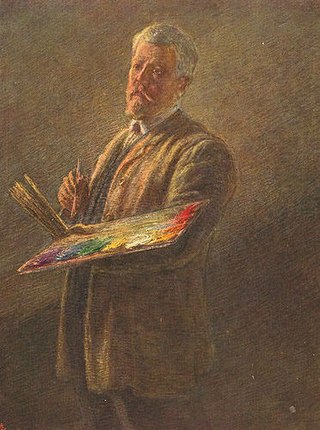This article needs additional citations for verification .(January 2014) |
Ada Mangilli (Cento, 23 September 1863 - Florence, 5 March 1935 [1] ) was an Italian painter.

This article needs additional citations for verification .(January 2014) |
Ada Mangilli (Cento, 23 September 1863 - Florence, 5 March 1935 [1] ) was an Italian painter.

She studied under professor Amos Cassioli. She mainly painted small oil canvases, some sold in the Netherlands by the merchant signor Hohlender. She often depicted women in Neo-pompeian scenes, such as a Bacchanalian celebration, in various stages of undress.
She also painted oil models, exhibited in 1879, for two mosaics on the left door of the Cathedral of Florence, depicting the blessed Bonifazio Lupi, Marquis of Soragna, founder of a Florentine charitable institution, and Piero di Luca Borsi, a popolano during the Republic, that had established the Arch-Confraternity of the Misericordia. She also painted a Tobias for the funerary chapel of the Cemetery of Antella near Florence. She also drew illustrations for the album Florentiu.
Among her works are: Baccante (gold medal at Exhibition of Fine Arts of Ferrara, and owned by the Pinacoteca), costume medioevale and Floralia. She painted a large canvas depicting Young Agrippa, exhibited at the Mostra Italiana del 1889 in London. At the Mostra Beatrice di Lavori femminili in 1890 at Florence, she exhibited a series of life-size figures: Le tre Marie, which won the first prize, a gold medal, for painting. She married Count Francesetti di Merzenile, who was known as a supporter of the arts. She also painted a Beatrice and Jesus forgiving the Adulterer. She lived and worked at the Villa alla Querce in Florence. [2]

Gaetano Previati (1852–1920) was an Italian Symbolist painter in the Divisionist style.
Adolfo Scarselli (1866–1945) was an Italian painter.

Francesco Sagliano was an Italian painter.

Valerico Laccetti or Valerio Laccetti was an Italian painter, mainly of pastoral genre themes.

Andrea Landini was an Italian painter.
Alcide Segoni was an Italian painter.
Antonio Varni was an Italian painter, painting vedute, historical, and genre pieces.
Giovanni Ponticelli was an Italian painter.

Francesco Saverio Netti was an Italian painter.
Domenico Pesenti was an Italian painter and antiquarian. He painted mainly vedute.

Raffaello Sorbi was a 19th-20th century Florentine painter, specializing in narrative painting.

Giuseppe Sciuti was an Italian painter.

Luigi Serra was an Italian painter, known for his watercolors.
Dario Querci was an Italian painter, mainly painting historical and literary subjects in a late-Neoclassic style.

Alberto Pisa was an Italian painter, often painting ruins, landscapes, and garden views in bright watercolor.
Elisa Rigutini or Elisa Rigutini Bulle was an Italian painter. She was a resident of Florence.
Ida Pinto-Sezzi was an Italian painter.
Linda Rocchi was an Italian painter, mainly of watercolors of flowers.

Luigi or Louis Rubio was an Italian painter, active in both Neoclassicism but later Romantic styles, painting mainly historic-mythologic canvases, as well as some genre subjects, and portraits. His works harked back to the Troubadour style twenty years earlier.
Fanny Pieroni-Davenport was an Italian painter, active mainly in Florence, mainly of portraits.